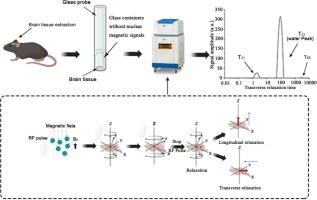Real-time detection of cerebral edema in mice based on low-field nuclear magnetic resonance
IF 4.9
2区 化学
Q1 CHEMISTRY, ANALYTICAL
引用次数: 0
Abstract
Cerebral edema is a secondary symptom of several conditions, including stroke, liver, failure, and severe craniocerebral injury. This study aimed to propose a Low-Field Nuclear Magnetic Resonance (LF-NMR) method for rapid and nondestructive measurement of brain water content and water phase state evaluating animal brain edema models. The water transverse relaxation time (T2) distribution in brain tissues was ascertained by measuring the T2 spectrograms of mouse brain tissues following various drying durations, in accordance with the shifting law of T2 peaks. A methodological study was carried out for the determination of water content in mouse brain tissue by the LF-NMR Peak Area (LF-NMR-PA) method using CuSO4 solution as standard solution. This method was studied in comparison with the wet/dry weight method and the Partial Least Squares Regression (PLSR) prediction method in normal and MCAO model mice, and further applied to the study of mannitol treatment of cerebral edema to validate the precision and accuracy of the hydration measurements as well as the method’s impact on subsequent experiments of cerebral infarct area measurement. In the T2 spectra of mouse brain tissues, the separate peaks T21 (0–10 ms), T22 (10–100 ms), and T23 (100–1000 ms) correspond to fat and bound water, water, and free water in brain tissue, respectively. The LF-NMR-PA method had good specificity, linearity, precision, stability, reproducibility, and recovery. The accuracy and range of use of the LF-NMR-PA method were better than those of the PLSR method, and its results were not significantly different from those of the wet/dry weight method. However, the short measurement time of the LF-NMR-PA method ensured the integrity of the tissues, and the determination of the moisture by this method did not have a significant effect on the subsequent determination of the area of cerebral infarction, which ensured the consistency of the experimental results.

基于低场核磁共振的小鼠脑水肿实时检测
脑水肿是中风、肝功能衰竭和严重颅脑损伤等多种疾病的继发症状。本研究旨在提出一种低场核磁共振(LF-NMR)方法,用于快速、无损地测量动物脑水肿模型的脑水含量和水相状态。根据 T2 峰移动规律,通过测量小鼠脑组织在不同干燥持续时间后的 T2 频谱图,确定了脑组织中水的横向弛豫时间(T2)分布。以 CuSO4 溶液为标准溶液,采用低频核磁共振峰面积(LF-NMR-PA)法测定了小鼠脑组织中的水分含量。该方法在正常小鼠和 MCAO 模型小鼠中与干湿重量法和部分最小二乘法回归预测法进行了比较研究,并进一步应用于甘露醇治疗脑水肿的研究,以验证水合测量的精确性和准确性以及该方法对后续脑梗塞面积测量实验的影响。在小鼠脑组织的 T2 光谱中,独立的峰 T21(0-10 ms)、T22(10-100 ms)和 T23(100-1000 ms)分别对应脑组织中的脂肪和结合水、水和自由水。LF-NMR-PA 方法具有良好的特异性、线性、精密度、稳定性、重现性和回收率。LF-NMR-PA 法的准确度和使用范围均优于 PLSR 法,其结果与湿重/干重法没有显著差异。但是,LF-NMR-PA 法测量时间短,保证了组织的完整性,而且该方法测定水分对后续测定脑梗死面积没有明显影响,保证了实验结果的一致性。
本文章由计算机程序翻译,如有差异,请以英文原文为准。
求助全文
约1分钟内获得全文
求助全文
来源期刊

Microchemical Journal
化学-分析化学
CiteScore
8.70
自引率
8.30%
发文量
1131
审稿时长
1.9 months
期刊介绍:
The Microchemical Journal is a peer reviewed journal devoted to all aspects and phases of analytical chemistry and chemical analysis. The Microchemical Journal publishes articles which are at the forefront of modern analytical chemistry and cover innovations in the techniques to the finest possible limits. This includes fundamental aspects, instrumentation, new developments, innovative and novel methods and applications including environmental and clinical field.
Traditional classical analytical methods such as spectrophotometry and titrimetry as well as established instrumentation methods such as flame and graphite furnace atomic absorption spectrometry, gas chromatography, and modified glassy or carbon electrode electrochemical methods will be considered, provided they show significant improvements and novelty compared to the established methods.
 求助内容:
求助内容: 应助结果提醒方式:
应助结果提醒方式:


